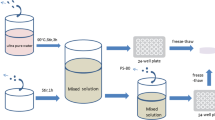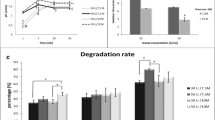Abstract
Chondroitin sulfate (CS) is considered as a possible candidate for the treatment of joint defect. This study is to evaluate the efficacy of intra-articular injection of CS carried by hydrogel in the treatment of chondral defects in adult rabbit models. Inclusion of CS (0–50 μg/ml) in in vitro chondrocyte culture exerts a dose-dependent increase in cell proliferation. To select for optimal carrier for in vivo study, the release kinetic of CS embedded in five types of hydrogel was studied using fluorescence technique and their biocompatibilities in vivo were investigated by injecting the CS-hydrogel into rabbit knees. α-CD-EG 4400 hydrogel was chosen as the carrier based on progressively released CS from the hydrogel, with 80% released by in one week while the remaining 20% was retained for 30 days. In vivo studies showed high biocompatibility of CS-hydrogel. To evaluate the efficacy of CS in the treatment of cartilage injury, chondral defects were created in femoral medial condyle (punch diameter 2.7 mm) or trochlea (punch diameter 3.5 mm) of the rabbits without damaging subchondral bone. CS (100 mg/ml) in 0.5 ml α-CD-EG 4400 hydrogel was then injected into the knee joint. Hydrogel and saline served as controls. On day 50 the chondral defect in the saline group showed no signs of healing and defect treated with hydrogel alone was covered with a thin and slightly irregular layer of fibrous tissue. The CS-hydrogel group showed a thicker layer composed of both hyaline and fibrocartilage. The modulus of elasticity was the highest in the CS-hydrogel group and lowest in the group injected with saline only. Our results suggest that intra-articular delivery of CS by α-CD-EG 4400 improved the biomechanical and histological properties of the repaired cartilage. It may be an effective treatment for cartilage injury.






Similar content being viewed by others
References
Brief AA, Maurer SG, Di Cesare PE (2001) Use of glucosamine and chondroitin sulfate in the management of osteoarthritis. J Am Acad Orthop Surg 9:71–78
Buckwalter JA, Mankin HJ (1998) Articular cartilage: degeneration and osteoarthritis, repair, regeneration and transplantation. AAOS Inst Course Lect 47:487–504
Creamer P (1997) Intra-articular corticosteroid injections in osteoarthritis: do they work and if so, how? Ann Rheum Dis 56:634–636
Hardingham T (1998) Chondroitin sulfate and joint disease. Osteoarthr Cartil 6(Suppl A):3–5
Hardingham TE, Fosang AJ (1992) Proteoglycans: many forms and many functions. FASEB J 6:861–870
Hunziker EB (2001) Articular cartilage repair: basic science and clinical progress. A review of the current status and prospects. Osteoarthr Cartil 10:432–463
Leeb BF, Schweitzer H, Montag K et al (2000) A metaanalysis of chondroitin sulfate in the treatment of osteoarthritis. J Rheumatol 27:205–211
Mitsuo O, Yuji U, Masatoshi T, Masakazu K (2002) Current concepts in tissue engineering technique for repair of cartilage defect. Artif Organs 25:172–179
O′Driscoll SW (1998) The healing and regeneration of articular cartilage. J Bone Joint Surg 80-A:1795–1812
Oliviero U, Sorrentino GP, De Paola P et al (1991) Effects of the treatment with matrix on elderly people with chronic articular degeneration. Drugs Exp Clin Res 17:45–51
Rasanen T, Messner K (1996) Regional variations of indentation stiffness and thickness of normal rabbit knee articular cartilage. J Biomed Mater Res 31:519–524
Richy F, Bruyere O, Ethgen O et al (2003) Structural and symptomatic efficacy of glucosamine and chondroitin in knee osteoarthritis: a comprehensive meta-analysis. Arch Intern Med 163:1514–1522
Uebelhart D, Thonar EJ, Delmas PD et al (1998a) Effects of oral chondroitin sulfate on the progression of knee osteoarthritis: a pilot study. Osteoarthr Cartil 6(Suppl A):39–46
Uebelhart D, Thonar EJ, Zhang J et al (1998b) Protective effect of exogenous chondroitin 4,6-sulfate in the acute degradation of articular cartilage in the rabbit. Osteoarthr Cartil 6(Suppl A):6–13
Volpi N (2003) Oral absorption and bioavailability of ichthyic origin chondroitin sulfate in healthy male volunteers. Osteoarthr Cartil 11:433–441
Wakitani S, Ono K, Goldberg VM et al (1994) Repair of large cartilage defects in weight-bearing and partial weight-bearing articular surfaces with allograft articular chondrocytes embedded in collagen gels. Trans Orthop Res Soc 19:238
Author information
Authors and Affiliations
Corresponding author
Additional information
Paper presented at ICRS and OARSI.
Rights and permissions
About this article
Cite this article
Hui, J.H., Chan, SW., Li, J. et al. Intra-articular delivery of chondroitin sulfate for the treatment of joint defects in rabbit model. J Mol Hist 38, 483–489 (2007). https://doi.org/10.1007/s10735-007-9120-7
Received:
Accepted:
Published:
Issue Date:
DOI: https://doi.org/10.1007/s10735-007-9120-7




